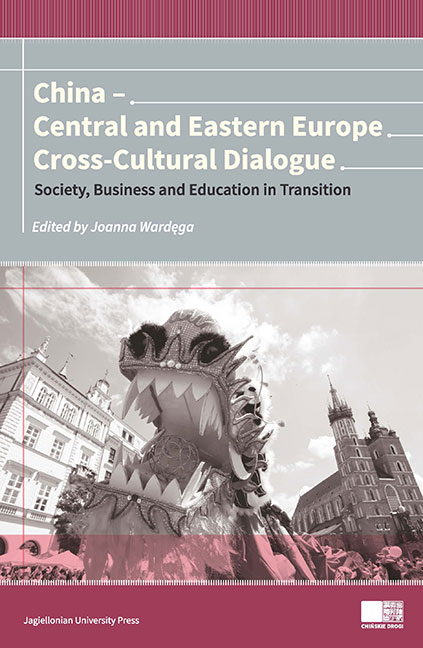Book contents
- Frontmatter
- Contents
- Foreword
- PART I Society and Culture in Transition
- Idealism and Relativism in Ethics: Comparing China and Central Eastern Europe (CEE)
- China's Role in the New World Order
- Redefining and Elderly Caregiving in the 21st Century China and Poland
- Roadmap for Moving to a Low Carbon Economy in China and Poland. Comparative Analysis
- Chinese Community in Poland – the Dynamics of its Development
- Perceptions of China among Central and Eastern European University Students
- Transformation of the Dragon – China's Image in the Polish Media
- Bridges and Obstacles in “the Way of the Ideal Government”: the Transition from Mind Confucianism to Political Confucianism from Jiang Qing's Point of View
- Conceptualizations of Constitutionalism in Recent China's Debates: Preliminary Typologies
- PART TWO Economy and Markets in Transition
- PART THREE Education in Transition
- Contributors
Chinese Community in Poland – the Dynamics of its Development
from PART I - Society and Culture in Transition
Published online by Cambridge University Press: 22 December 2017
- Frontmatter
- Contents
- Foreword
- PART I Society and Culture in Transition
- Idealism and Relativism in Ethics: Comparing China and Central Eastern Europe (CEE)
- China's Role in the New World Order
- Redefining and Elderly Caregiving in the 21st Century China and Poland
- Roadmap for Moving to a Low Carbon Economy in China and Poland. Comparative Analysis
- Chinese Community in Poland – the Dynamics of its Development
- Perceptions of China among Central and Eastern European University Students
- Transformation of the Dragon – China's Image in the Polish Media
- Bridges and Obstacles in “the Way of the Ideal Government”: the Transition from Mind Confucianism to Political Confucianism from Jiang Qing's Point of View
- Conceptualizations of Constitutionalism in Recent China's Debates: Preliminary Typologies
- PART TWO Economy and Markets in Transition
- PART THREE Education in Transition
- Contributors
Summary
Poland is an ethnically homogeneous country, and traditional foreign national groups are those originating from the bordering countries, and in recent years also from the European Union. The immigrant population from Asia for many years has been dominated by the Vietnamese, quite well organized and integrated. Chinese immigration to Poland does not have a long history. Among all the groups of a foreign origin in Poland, the Chinese are of a relatively small number, around 2,5 percent. Despite that, a rapid development may be observed in last few decades. The presence of this national group is visible in clusters, mainly in Warsaw and some other cities, where the branches of Chinese enterprises are located. Only individuals have settled outside these centres. Due to the short history of migration and a relatively low level of integration with the host society, the Chinese have not created a stable organization nor active institutions that would support their functioning in the new country. The following text is an attempt to describe the size and the forms of immigration, settlement structure, and rare organizations in which they operate. It was also intended to outline the prospects for the future development of this national group in Poland on the basis of the existing forms of cohabitation.
Overview of the Chinese immigration to Poland
Historically, Central and Eastern Europe wasn't a traditional destination for the Chinese immigration. In the pre-war period, the number of the Chinese in Central Europe was negligible (Nyiri, 2007, p. 29). In the first decades after World War II, there was no growth either as only individuals were arriving there, such as for instance the exchange students. The Chinese arrived in this part of Europe in larger groups in 1989–1991, mainly due to the abolition of Hungarian visas. As a result, in a very short period of time in that country the number of the Chinese rose to 40,000 (Nyiri, 2007, p. 54). Later, many of them re-emigrated to Poland, the Czech Republic, Slovakia and Romania. After the tightening of visa policy in Hungary, new destinations emerged: Romania and the Czech Republic (also as a trail of transfer to Western Europe), and subsequently Slovenia, Poland, Albania, Bulgaria, Ukraine, Lithuania. The number of the Chinese in Central and Eastern Europe can be estimated at around 50,000 (Nyiri, 2007, p. 137).
- Type
- Chapter
- Information
- China - Central and Eastern Europe Cross-Cultural Dialogue Society, Business and Education in Transition , pp. 83 - 102Publisher: Jagiellonian University PressPrint publication year: 2016



